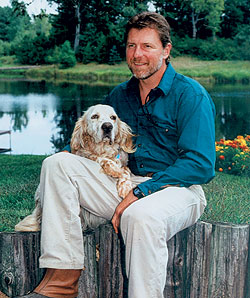By James B. Spencer
 Paul McGagh |
SPANIELS
This tip is from Paul McGagh of Glencoe Farm and Kennel, 5488 South Highway 1804, Bismarck, ND 58504; (701) 226-3194; www.glencoekennels.com; pgmcgagh@aol.com. Paul has been training professionally for 23 years, specializing in training spaniels for hunting, hunting tests and field trials. As a field-trial competitor, he has won three U.S. National Cocker Championships.
In 2006 he won the English Springer Spaniel USA Open High Point Award. He judged the 2006 U.S. Cocker National Championship, the 2006 USA English Springer National Championship and the 2006 Canadian Spaniel Championship. He breeds English springers and English cockers.
Honoring
"Honoring has a broad spectrum of implications, but for the hunting spaniel I would define it as not interfering with another dog's retrieve," Paul said. "It's a demonstration of patience under trying circumstances."
The spaniel that honors hups when another dog flushes a bird and remains sitting through the other dog's retrieve. Paul equates the required training with creating an "off switch" for the dog's instincts. He recommends starting this gently as soon as the puppy understands what hup means.
| More Honoring Tips | 

Don't miss part 1 of this story about your pointer here., or part 2 for your retriever here.
|
|
"Have your pup hup and wait before eating, before walking through a doorway, before leaving his crate, before jumping into the car and so on," he said. "Each of these little routines helps build patience in the puppy. Of course, the caveat is that, with a puppy you must have patience yourself, as well as a sense of humor and a gentle hand."
Much later on, after the youngster has been steadied to wing, shot and fall, Paul trains him to honor as an extension of the steadying process. For this, he and an assistant work two well-steadied dogs as a brace on parallel beats ala the field-trial format. Both dogs must hup at every flush, regardless of which dog puts the bird in the air. Then, to keep both dogs rock-solid, Paul varies the retrieving routine from flush to flush.
Sometimes he has the flushing dog retrieve the bird; sometimes he has the honoring dog retrieve it; and sometimes he doesn't allow either dog to retrieve, but walks out and picks up the bird himself. If either dog breaks, Paul re-positions him where he should have remained, and then gives the other dog several retrieves right past the erring dog.
Paul uses a clever technique for curing dogs of creeping, which he says is a common problem for cockers. He sets up a wooden box (about two-feet by three-feet by one-foot high) and has the offending dog hup on the box. Then he releases a homing pigeon a reasonable distance in front of the dog. If the dog creeps, he falls off the box and is corrected appropriately for his temperament.
When the dog remains sitting, Paul moves closer to the dog before releasing the homer, and so on until he can release it right under the dog's nose without inducing him to creep.
To generalize this training, Paul moves the box to a new location before each session.
Eventually, he moves this entire drill off the box and onto the ground.
He also uses a pair of these wooden boxes in teaching honoring. He sets up two boxes about 10 yards apart, and has an older more experienced dog hup on one box while the "trainee" dog hups on the other. He tosses a dizzied pigeon in front of the older dog, and releases the older dog to flush the bird while Paul keeps close tabs on the other dog. After the dog demonstrates steadiness in this drill, Paul alternates where he tosses the bird, sometimes in front of each dog, letting each dog flush the birds that fall in front of him.
This is an excellent drill for both steadiness and honoring. It also prevents either dog from creeping. Paul transfers this drill to the ground as soon as he can.
In actual fieldwork, Paul will sometimes reward a dog for a successful honor by tossing a dead bird for him to retrieve after the other dog has completed his retrieve. Paul has another reward for any successful performance in the field, not just honoring: He tosses a tennis ball for the dog to retrieve.
"Spaniels just love tennis balls, and I carry them by the dozen when I'm training," he said.
Paul said that in his native England, hunters use a technique for hunting two spaniels that he seldom sees practiced in this country. They keep one dog at heel while the other quarters and hunts. Then, they switch dogs periodically.
"That way they always have a fresh dog hunting for them while the other dog is resting at heel," he said. "I don't understand why more hunters in this country don't work their dogs this way. It works so marvelously that it's my favorite way of hunting."






